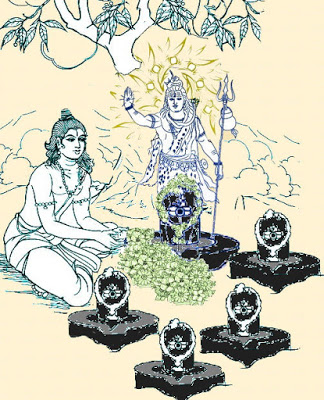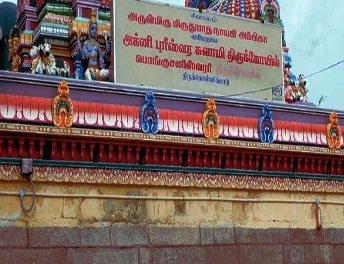
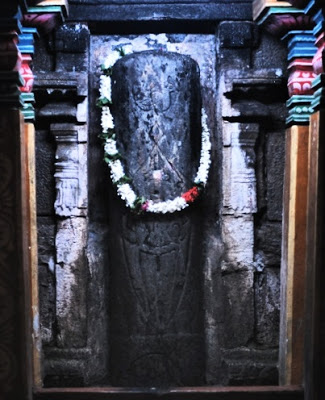
{The above shown Lingam or Phallic symbol was rescued from the ruble of the original temple destroyed by the Portuguese colonial officers in 1595 (?)and installed in the outer wall of the newly renovated temple in the 1900s. Hence apart from possibly the foundation this is the only part of the temple that predates the arrival of Europeans in Sri Lanka in 1505.

During the invasion of Sri Lanka by Portuguese, they destroyed hundreds of Hindu temples and looted valuables from them. Even several thousand years old temples which were historically and archaeologically important in nature and structures were literally demolished beyond repairs. Muneeswaram temple was destroyed twice by the Portuguese who handed over the properties to the Christians. Although a Catholic chapel was built over the temple foundation, subsequently the locals removed the Chapel to reconstruct the temple on both the times.
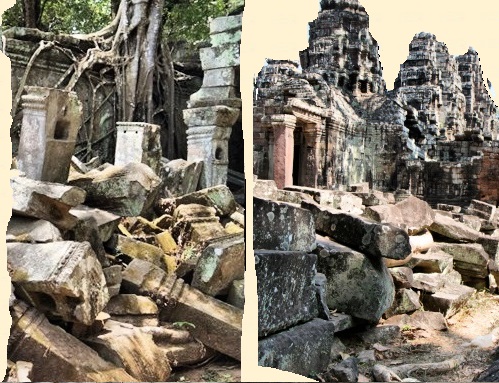
The historians state that once upon a time Sri Lanka was a huge mass of land and subsequent earthquakes, sea storms and landslides caused destruction of two thirds of the original Sri Lankan territory. It is also stated that the lands which submerged into the sea were the original territories ruled by King Ravan, and one could enter the then Sri Lanka mainland only through those territories submerged into the sea. Perhaps the Pancha Linga shrines may have been established by King Ravan who was a great devotee of Lord Shiva in and around the places ruled by him and they have survived destruction by earthquakes and storms from sea. The Village lore, as floated by word of mouth stories on Munneeswaram has it that when Lord Rama rescued Goddess Sita from the clutches of Ravan, he visited Lord Shiva’s temple in Munneeswaram to offer prayers and worship to Lord Shiva who had earlier graced him to win the war against the demon King Ravan.
Munneeswaram temple in the territory of Chavakatchery in Sri Lanka is said to be 2000 years old, but since the myths surrounding the temple associate it with the popular Indian epic Ramayana the time period attributed to the Munneeswaram by the historians and researches may not be truly reflecting its original age as Ramayana has occurred several thousands of years ago.
Even though the temple remained ruined due to protracted inland war between Tamils and Sri Lankans, they could in no way erase the importance or the greatness of the temple. The Shiva Linga inside the temple is reported to be self manifested. Several temples which were destroyed by the invading Portuguese and Dutch rulers were resurrected during the British rule and this temple too was one amongst them.
As per Puran, the greatness of this temple has been revealed to the Rishies and sages by the greatest sage of sages Suthaga in Naimisharanya forest by way of daily discourse. Sage Suthaga narrated the story of Ramayana and then in between he narrated the glory and history of the temple at Munneeswaram. Since everyone knows the story of Ramayana, only the story relevant to the glory of Munneeswaram Lord Shiva temple is narrated below.
Sage Suthaga told thus. “This temple has history with Ramayana. After Ravan abducted Goddess Sita, with the help of Jadayu, Vali, Sugreeva and Hanuman Lord Rama was able to rescue her after a great fight. Divine bird Jadayu lost her life in the episode. Because Lord Rama killed Ravan who was considered to be a highly learned Brahmin and also his soldiers, Lord Rama was afflicted with Brahmahathi Dosha.
Buoyed with Lord Shiva’s grace, Lord Rama marched ahead and won the war and while returning back with his spouse Goddess Sita, on way, he offered oblation to Lord Shiva in many temples, and finally reached the same spot where he had earlier offered worship to Lord and received his grace before proceeding on war with Ravan. When Lord Rama reached the spot where he performed the pooja, the Shiva Ling was not there but he realized to his wonder that a vital part of Brahmahathi Dosha had vanished even before he offered oblation to Lord Shiva. Therefore Lord Rama carved out a small Shiva Linga made out of sand clay and offered his prayers. Pleased with the act Lord Shiva who again appeared before Lord Rama advised him that in order to get rid of the remaining elements of Brahmahathi dosha he (Lord Rama) will have to set up four more Shiva lingas in four directions which included Rameswaram and offer prayers there. Only then the entire malefic effects of Brahmahathi dosha will vanish. That was because during the war Lord Rama was surrounded on all sides by the army of Ravan and in the fight, Lord Rama had to kill many of them spread on all sides and therefore he attained Brahmahathi dosha of four directions and to remove the malefic effects of them he had to visit Lord Shiva temples on all the four sides and establish Shiva Lingas to get rid of the malefic effects of Brahmahathi Dosha completely. Only by visiting and offering prayers on those specific temples each element of the Brahmahathi Dosha would vanish pronounced Lord Shiva. However the crux of the curse was that out of many elements in the Brahmahathi Dosha unless the vital part of Brahmahathi Dosha is wiped out, which was possible only if he offered prayers in Munneeswaram’s Lord Shiva temple, not even a bit of other elements of the dosha will go away even if Lord Rama visited the other specific temples and offered prayers.
Lord Rama did not know that Lord Shiva had already manifested and remained underground in the same place in Munneeswaram in the form of a Shiva Linga. Therefore when Lord Rama performed Pooja to the Shiva Linga which he had made out of clay and offered Pooja in the same spot where the Shiv Ling was hidden underground, it automatically absorbed the divine energies of Lord Shiva. Thus Munneeswaram has the Shiva Ling with the divine energies of Lord Shiva as established by another divine Lord Rama. Goddess Parvathi had also manifested here in the name of Vadivaambika to grace and bless the devotees who come there to offer prayers”.
The rishies and sages who were assembled there and heard in rapt attention the discourse of Suthaga Muni and were curious to know the events which led to the manifestation of the Goddess Parvathi. Sage Suthaga continued to narrate the story to the anxious sages and rishies seated there.
‘In Kalpa Kala a fisherman was living nearby the present temple site. Every day he went to the river side of the temple (the temple did not exist then), netted fishes and sold them which was the only source of income for his family. One day as usual when he went out for fishing, he happened to see two youngsters, a boy and a girl happily playing at a distance away. They were pretty beautiful and their body was shining like gold. An astonished fisherman could not believe such a pretty beautiful children could be there in the village as he knew each and every family who were all poor and none had children of the kind that he witnessed there and therefore he was sure that they could not belong to that village. Anxious stuck fisherman went towards them to speak to them. The moment he marched towards the children they disappeared. He searched all over seashore but could not find them. There was no hiding place too and the entire place was seashore. Where they would have gone or are they spirits or ghosts ? Mentally confused fisherman went home pondering over the incident, his questions remained unanswered.
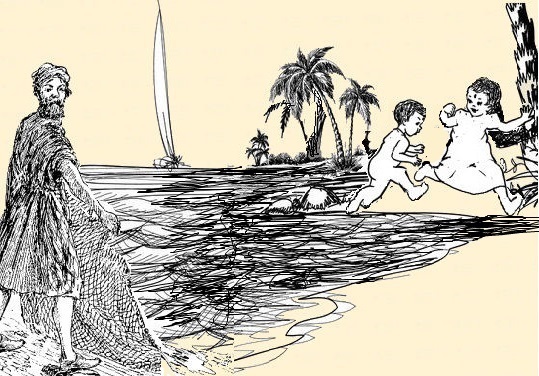 Next three days the same game happened. Whenever he tried to go near them they disappeared without leaving any trace. He wondered what could be the reason for their disappearance once he attempted to reach them. Therefore determined to catch them on the fourth day he hid behind a tree near to the place where they usually played. Time passed and as usual the youngsters appeared and began to play. The fisherman slowly moved forward and somehow managed to catch them, but the boy escaped by jumping into the sea and disappeared. Shockingly the girl whom the fisherman got turned into an idol. Shocked fisherman took the statue home and decided to seek the advice of some pundits next day and slept. In his dream appeared Goddess Parvathi who said the girl whom he caught was none but she alone, and if her statue is enshrined in a temple there and worshipped the nation will prosper.
Next three days the same game happened. Whenever he tried to go near them they disappeared without leaving any trace. He wondered what could be the reason for their disappearance once he attempted to reach them. Therefore determined to catch them on the fourth day he hid behind a tree near to the place where they usually played. Time passed and as usual the youngsters appeared and began to play. The fisherman slowly moved forward and somehow managed to catch them, but the boy escaped by jumping into the sea and disappeared. Shockingly the girl whom the fisherman got turned into an idol. Shocked fisherman took the statue home and decided to seek the advice of some pundits next day and slept. In his dream appeared Goddess Parvathi who said the girl whom he caught was none but she alone, and if her statue is enshrined in a temple there and worshipped the nation will prosper. Trembled fisherman woke up next morning and consulted the neighbors on the story. As the news spread like wild fire, the King too came to hear the news. Already he was facing quite a no of internal problems and therefore he summoned the fisherman along with the statute.
The King could not believe the narration of the fisherman and wondered whether such an event could happen and whether the fisherman was actually telling the truth. In order to find out the truth he directed the fisherman to leave the idol in the palace and then collect it thereafter when he would call him. The King ordered his staff to arrange for one hundred percent matching idols similar to the original idol and kept all of them arranged in several rows along with the original idol which had a hidden mark. He called the fisherman on the fourth day and asked him to pick up the original idol. He cautioned the fisherman that if it is found that he was telling a lie, he would be imprisoned for life and if the correct idol is picked up by the fisherman, then only he would believe the story and carry out the command of the Goddess as told him in his dream.
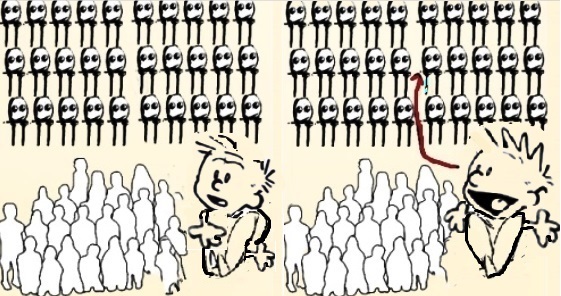 The fisherman was worried. If he can not find out the original idol then how to escape imprisonment? But the same devi again appeared in his dream and encouraged him saying ‘do not worry my son. Go to the Palace and identify the idol whose right leg will move as you see and it will be visible only to you. That will be the original one and till you pick me up, the leg will keep shaking’. Next day the fisherman went to the palace, court assembled and the hundred idols, brought and kept arranged in few rows. Thereafter the king asked the fisherman to find the original statue from amongst the hundred idols kept there.
The fisherman was worried. If he can not find out the original idol then how to escape imprisonment? But the same devi again appeared in his dream and encouraged him saying ‘do not worry my son. Go to the Palace and identify the idol whose right leg will move as you see and it will be visible only to you. That will be the original one and till you pick me up, the leg will keep shaking’. Next day the fisherman went to the palace, court assembled and the hundred idols, brought and kept arranged in few rows. Thereafter the king asked the fisherman to find the original statue from amongst the hundred idols kept there. The King was too pleased and promised to establish a temple for her and send back the fisherman giving him lots of money and reward. Next in consultation with his Raja gurus, he established a temple on an auspicious day and enshrined the statute along with Lingeswar (Shiva Linga) in the present temple site. It is said that the present idol of the devi enshrined in the sanctum of the temple is the very same idol found initially by the fisherman”.
The name of the Lord in this temple is Munnainatha Peruman meaning the lord who had already manifested in the same land several centuries before the shrine came up. It is believed that Lord Rama performed Pooja to the same invisible Shiva Ling buried underground. The name of the Devi, consort of Lord Shiva here is Vadivambika. Sage Vyasa reportedly visited this temple to offer prayers. The general belief is that those who visit this temple and offer worship they will get rid of their past sins and if the Karma is performed for the ancestors who had died and gone, their souls will rest in peace and in turn comes up there invisible to everyone o bless their family members on earth.
It is said that King Vijaya who was the ruler of Sri Lanka repaired the temple and reconstructed it. Many of the Sinhalese rulers too contributed wealth to this temple. In 17th century one of the Kings named Raja Singham belonging to Vaishnavite sect dispatched sculptures from his country to repair the temple which was ruined by the invading forces. The pundits say that there are references in the Dakshina Kailaya text on the greatness of this temple. There are three big precincts to enable the devotees go in circle around the temple. The three precincts or passages are called Ul (inner) Veedi, Raja (King) Veedi and Mada (General) Veedi (Veedi means road or passage). The temple is situated 82 kilometers from Colombo.
As far as the Tamil speaking Hindus were concerned the Munneeswaram temple was primarily a Saivite temple. As far as the Sinhalese Buddhists were concerned they believe Munneeswaram to be a goddess temple associated with Goddess Kali. Some myths of Sinhalese tells that one of their female deity called Goddess Pattini in Sri Lanka persuaded Goddess Kali from devouring human beings and ensured that she settled down in Munneeswaram.
According to two myths, two Kings namely Rajasinghe, a ruler from Sinhalese race, and Kullakotan, ruler from Tamil race were afflicted with an incurable skin disease and were cured after taking a bath in the ruined temple’s holy pond. Following the miracle cure they renovated the ruined temple. But there are no historical text that substantiates these claims and is floated by word of mouth stories only. Most of the myths associated with the temple are not historically texted and vary with both Tamils and Sinhalese version.

